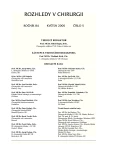Miniinvasive Laparoscopic or Retroperitoneoscopic Radical Nephrectomy for the Parenchymal Tumor
Authors:
M. Hora 1; J. Klečka jr. 1; O. Hes 2; J. Ferda 3; T. Ürge 1
Authors‘ workplace:
Urologická klinika LF UK a FN Plzeň, přednosta doc. MUDr. M. Hora, Ph. D.
1; Šiklův patologicko-anatomický ústav LF UK a FN Plzeň, přednosta prof. MUDr. M. Michal
2; Radiodiagnostická klinika LF UK a FN Plzeň, přednosta doc. MUDr. B. Kreuzberg, CSc.
3
Published in:
Rozhl. Chir., 2005, roč. 84, č. 5, s. 246-252.
Category:
Monothematic special - Original
Overview
Introduction:
Laparoscopic (LRNE) or retroperitoneoscopic (RRNE) radical nefrectomy originally published in 1991, respectively in 1993, began to be introduced in common practice at the end of the 20th century. In this work we summarize our findings gathered upon introduction of these methods.
Subjects and methodology:
We present a group of 50 miniinvasive nephrectomies conducted during 2003–2004 (46 LRNE and 4 RRNE). LRNE was combined with ipsilateral adrenalectomy in five cases and with cholecystectomy in three cases (in all cases the LRNE was on the right side).
Results:
The mean age of the patient subjects was 65 ± 11 years (34–81). The blood loss was 134 ± 201 ml (30–1200). The tumor size according to the CT was 50 ± 13 mm (30–82). Histologically, 45x renal carcinomas, 4x oncocytomas, 1x urothelial carcinomas were diagnosed. The drain was removed 2.1 ± 0.9 days following the surgery. The mean hospitalization time was 6.1 ± 1.6 days (4–9). Only a single major, however lethal, complication arised: In a 74-year old female, the left-sided LRNE due to the carcinoma pT3bG2 and at the same time vaginal hysterectomy, extraction of the renal preparation through the vagina and anterior and posterior vaginoplasty (for a prolaps) were conducted. The patient was repeatedly revised for haemoperitoneum and she exited on the 18th postoperative day due to pneumonia. The mean duration of the LRNE was 168 ± 40 minutes (80–265). The combined LRNE and cholecystomic procedure lasted 265 minutes. The mean duration of the LRNE with CHE was 213 minutes, and of the LRNE with adrenalectomy was 170 minutes. In 4 cases of the RRNE (indicated three times due to preceeding major surgical procedures in the abdominal cavity and once for the Crohn‘s disease) the mean duration was 203 minutes.
Conclusion:
Miniinvasive RNE in TI tumors is a modern reproducible methodology suitable for application in clinical practice. The laparoscopic approach appears more appropriate. The retroperitoneoscopic approach is indicated mainly in cases of postoperative adhesions in the abdominal cavity.
Key words:
renal tumor – miniinvasive approach – nephrectomy – laparoscopy – retroperitoneoscopy
Labels
Surgery Orthopaedics Trauma surgeryArticle was published in
Perspectives in Surgery

2005 Issue 5
Most read in this issue
- Postcathetrisation Pseudoaneurysm of the Radial Artery
- Elective Open Appendectomy versus Elective Laparoscopic Appendectomy in Women. A Retrospective Study
- The Pedicled Rectus Femoris Muscle Flap for Reconstruction of Complicated Abdominal Wall Defects
- Minimally Invasive Saphenous Vein Harvesting for Coronary Artery Bypass Grafting. Use of Vega System®
